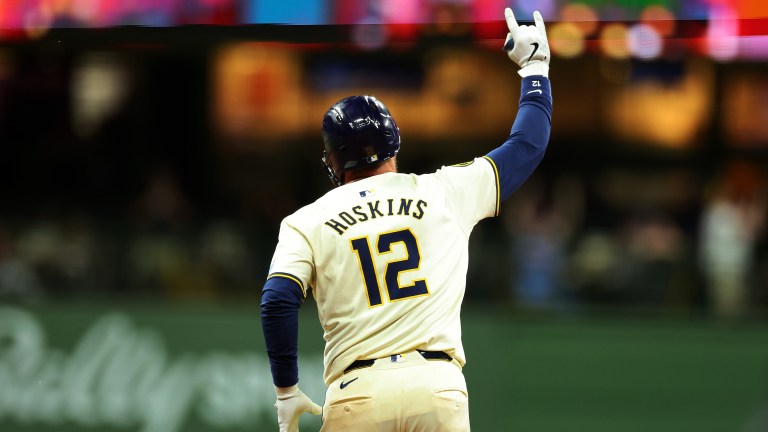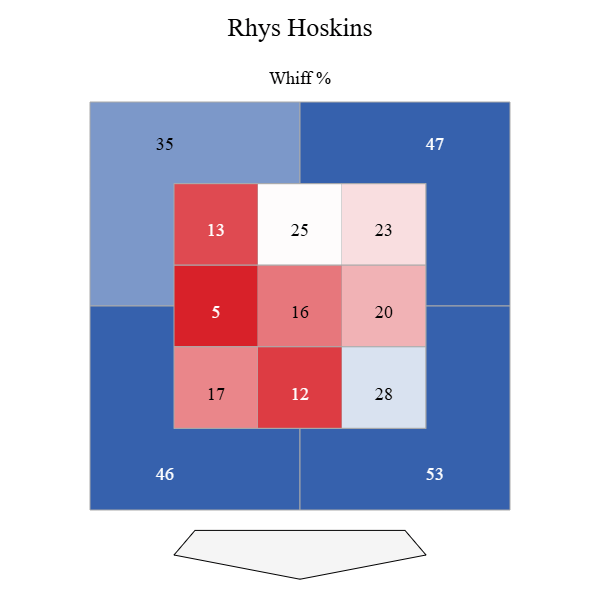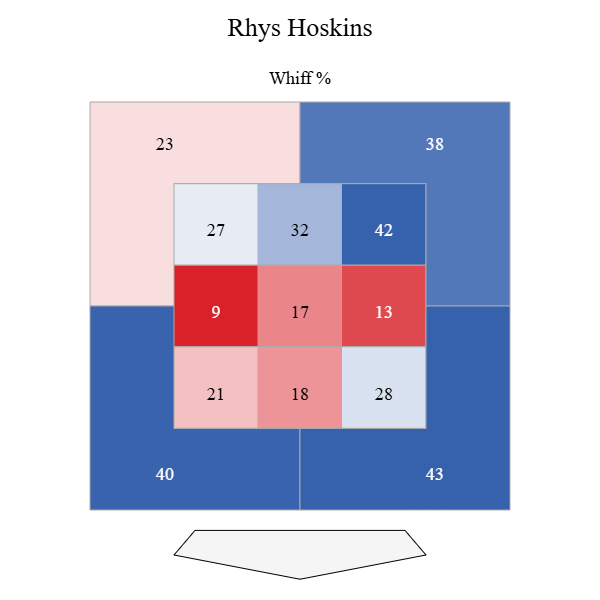Can Rhys Hoskins Bounce Back in 2025?
After an underwhelming first year in a Brewers uniform, can Rhys Hoskins return to form for Milwaukee in 2025?

Over the course of his six seasons in Philadelphia, Rhys Hoskins was one of the most reliable producers at the first base position. He hit for a good average, he got on-base at a high level with a strong approach, and he provided a consistent source of power.
But after joining the Milwaukee Brewers last winter via free agency, his results at the plate took a step back in 2024.
His counting stats were respectable come seasons’ end, but he looked like a shell of the hitter he once was in Philadelphia at times throughout the season.
He’ll be another year removed from the ACL tear he suffered back in March of 2023 this coming season, and perhaps having a full offseason to develop within the Brewers’ organization can yield better results in 2025.
In order for that to happen though, there are several areas of his game Hoskins will need to improve upon if he wishes to return to form.
Hoskins’ 2024 Quality of Contact
Despite seeing a dip in certain quality of contact metrics, Hoskins was still a valuable power bat for the Brewers in 2024.
Last season, Hoskins’ average exit velocity dropped 1.4 mph from his number in 2022, and his hard-hit rate also fell over two percent as well. Both of those metrics have decreased with each successive season dating back to 2020.
Likewise, his maximum exit velocity last season was 109.6 mph, which was the lowest mark of his career. Now, that alone isn’t a huge deal. But combine the step back in his maximum power output with his decreased exit velocity on a per-batted-ball basis, and those two trends together spark some concern.
Yet, Hoskins still managed to up his barrel rate to 12.7%, which was a 1.6% increase from 2022. That was a major contributor to his 26 homers (the second most on the Brewers), and that led to a great deal of run production, as he ended the year with 82 RBIs.
The expected metrics suggest Hoskins had an even worse season than his true stats indicated (.387 xSLG, .301 xwOBA), but at the end of the day it was very encouraging to see him maintain his high home run totals despite the dip in hit quality.
His velocity numbers will certainly be something to monitor in 2025. But given his track record, it feels as if Hoskins has a floor of 25 homers with room for more if he can take even a slight step forward in this department next season.
A Major Shift in Offensive Approach
Where Hoskins saw the biggest change in 2024 was his offensive approach.
He still walked at a high level though, as he finished in the 76th percentile in walk rate at 10.3%. That was right in line with his walk rate from his previous two seasons (10.6% in 2021, 10.7% in 2022). Fans can probably expect to see something similar to that mark again in 2025.
Where Hoskins saw a dramatic step back was in the strikeout department, and that played a big role in his inefficiency at the plate.
Dating back to 2020, Hoskins’ strikeout rate has elevated in each of his last three seasons. It reached a new career-high in 2024 at 28.8%.
That was a jump of nearly four percent from 2022 and was in the 10th percentile in all of baseball. Of course, that’s a number Hoskins will look to bring down in 2025.
For years, Hoskins built his offensive success around having a strong approach. But he strayed from that formula in 2024, and his results tapered off as a result.
More Chase and Less Overall Contact in 2024
Hoskins’ chase rate rose to a career-high 25.4% in 2024, which was a 2.2% increase from the previous season. Not only was he expanding the strike zone more often, but his bat-to-ball numbers also diminished in a significant way.
Hoskins’ whiff rate of 26.3% doesn’t particularly seem like a glaring red flag on the surface level, as it was only a 0.6% increase from 2022. However, that number doesn’t tell the whole story, as it is largely skewed by his chase contact rate that rose from 52.2% in 2022 to 61% in 2024.
Alternatively, it was Hoskins’ drop in contact rate within the strike zone that should draw most of the attention. Hoskins’ in-zone contact rate dropped four percent from 2022 to a career-low mark of 78.8%. That’s a substantial drop, especially considering his career zone-contact rate sits at 82.2%.
Hoskins isn’t the type of hitter to make an impact by spoiling pitches that are outside of the strike zone. So while his leap in that department was impressive, it didn’t contribute to a whole lot of offensive value.
Instead, Hoskins has had a great offensive success by doing damage on pitches within the strike zone and capitalizing on pitches over the heart of the plate throughout his career.
That is the area that regressed in a big way last season, and addressing that part of his game should be priority No. 1 this offseason.


The two images above highlight Hoskins’ whiff rate, broken down by different parts of the strike zone, from his 2022 season (the first image) and his 2024 season (the second image).
Hoskins saw a dramatic decrease in contact rate at the top of the strike zone last season. Given that hitters tend to see fastballs more often than any other pitch at the top of the strike zone, perhaps his inflated whiff rate in this part of the strike zone coincides with his declined performance against fastballs in 2024.
Diminished Performance Against Fastballs
Hoskins has historically been very effective against heaters throughout his career, but his numbers against the pitch type took a big step back in 2024.
Below are Hoskins’ numbers against four-seam fastballs and sinkers across his three most recent seasons.
| 2021 | BA: .254 | SLG: .580 | xWOBA: .401 | Whiff%: 18.7% | K%: 18.1% | Hard Hit%: 54.1% |
| 2022 | BA: .272 | SLG: .495 | xWOBA: .355 | Whiff%: 21.5% | K%: 20.8% | Hard Hit%: 45.6% |
| 2024 | BA: .222 | SLG: .468 | xWOBA: .312 | Whiff%: 26.6% | K%: 31.1% | Hard Hit%: 46.3% |
| 2021 | BA: .250 | SLG: .450 | xWOBA: .412 | Whiff%: 18.2% | K%: 14.3% | Hard Hit%: 34.7% |
| 2022 | BA: .305 | SLG: .543 | xWOBA: .389 | Whiff%: 14.7% | K%: 12% | Hard Hit%: 46.2% |
| 2024 | BA: .253 | SLG: .407 | xWOBA: .339 | Whiff%: 13.1% | K%: 17.6% | Hard Hit%: 40.5% |
Against four-seamers, Hoskins’ batting average took a noticeable step back, and his quality of contact was greatly diminished. On top of doing a fraction of the damage against the pitch, his whiff rate also rose over five percent, and his strikeout rate jumped over 10 ticks to 31.1%.
That’s unusual for Hoskins given his track record against four-seam fastballs, and perhaps his leap in whiff rate and strikeout totals against the four-seamer helps explain his elevated punchout rate at the top of the strike zone last season.
It was a similar story with sinkers. While his contact numbers were respectable, his slugging percentage and overall quality of contact plummeted compared to previous seasons.
Those two pitch types made up nearly 50% of the pitches Hoskins saw last season. Not to mention Hoskins also hit .158 with a wOBA of .246 against breaking balls- a pitch type he saw 35.7% of the time as well.
All in all, there were too many holes in Hoskins’ game last season, and pitchers had various different ways to attack him. That was unusual to see from a hitter like Hoskins who has been so consistent throughout his career.
Can Hoskins Find His Way in 2025?
It wasn’t just one thing that went wrong for Hoskins, but instead it was a step back in several aspects of his game that compounded upon one another.
Whether or not he can turn in better results in 2025 will largely stem from his ability to tighten up his approach and get it back to the level we saw throughout his tenure with the Phillies.
Hoskins will be 32 years old on Opening Day, and the recent trends in his quality of contact data suggest that perhaps his best days are behind him.
But that doesn’t mean Hoskins can’t be a valuable hitter in 2025. Overall, it was encouraging to see that even in the worst year of his career, Hoskins was still a league average hitter by wRC+ and was still a reliable source of homers and run production, giving him a nice floor to build upon.
Expecting him to return to the level of production we saw from his early days in Philadelphia feels like wishful thinking. But I trust his track record enough to believe he can still produce something between that and what we saw from him in 2024.
